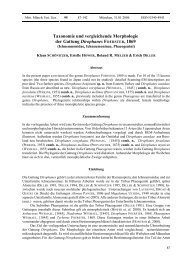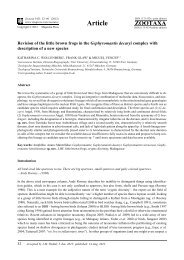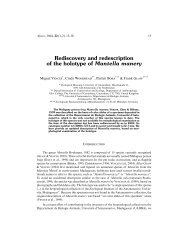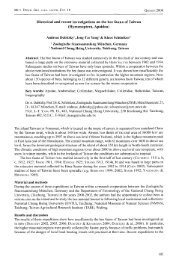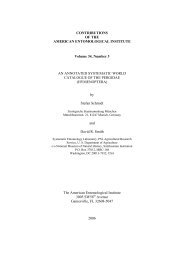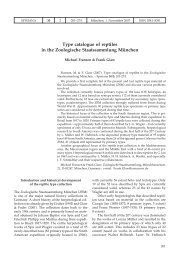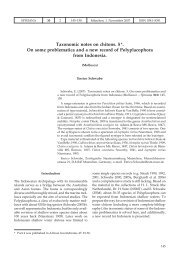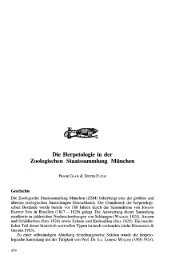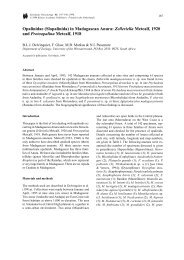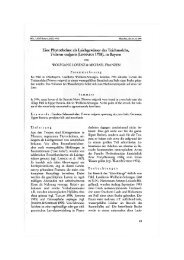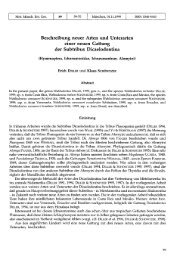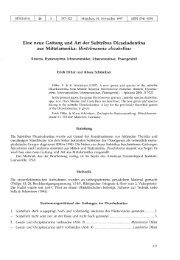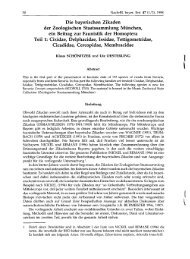The Malagasy snake Pseudoxyrhopus ambreensis preys upon ...
The Malagasy snake Pseudoxyrhopus ambreensis preys upon ...
The Malagasy snake Pseudoxyrhopus ambreensis preys upon ...
You also want an ePaper? Increase the reach of your titles
YUMPU automatically turns print PDFs into web optimized ePapers that Google loves.
Herpetology Notes, volume 2: 161-162 (2009) (published online on 05 October 2009)<br />
<strong>The</strong> <strong>Malagasy</strong> <strong>snake</strong> <strong>Pseudoxyrhopus</strong> <strong>ambreensis</strong><br />
<strong>preys</strong> <strong>upon</strong> chameleon eggs by shell slitting<br />
<strong>Pseudoxyrhopus</strong> <strong>ambreensis</strong> (Fig. 1) is a small-sized<br />
<strong>snake</strong> (total length up to 423 mm), known only from the<br />
rainforests of Montagne d’Ambre National Park and the<br />
Tsaratanana massif in northern Madagascar (Andreone<br />
et al. 2009). Its activity is mainly nocturnal and it has an<br />
obvious tendency to burrow (Glaw & Vences 2007). Only<br />
four food records are available for the eleven species<br />
recognised in the genus <strong>Pseudoxyrhopus</strong>: Raxworthy &<br />
Nussbaum (1994) reported a specimen of P. kely that<br />
contained an adult skink (Madascincus melanopleura).<br />
Remains of a rodent, probably Nesomys rufus, were<br />
found in the intestine of an adult P. tritaeniatus by Cadle<br />
(1999). A juvenile of P. oblectator had eaten five eggs<br />
of the skink Madascincus melanopleura (Cadle 1999).<br />
Finally, a female of P. imerinae was found while preying<br />
<strong>upon</strong> ten eggs laid by a lizard, presumably the iguanid<br />
Oplurus quadrimaculatus (Andreone et al. 2007).<br />
Based on his single observation on egg predation<br />
in <strong>Pseudoxyrhopus</strong> oblectator, Cadle (1999)<br />
already suggested that the posterior fangs in some<br />
<strong>Pseudoxyrhopus</strong> may play a more important role in egg<br />
Angelika Knoll 1 , Frank Glaw 2 and Jörn Köhler* 1<br />
Abstract. We report on two individuals of the <strong>Malagasy</strong> lamprophiid <strong>snake</strong> <strong>Pseudoxyrhopus</strong> <strong>ambreensis</strong> from Montagne d’Ambre<br />
National Park which had ingested three and four chameleon eggs, respectively. <strong>The</strong> chameleon eggs most probably correspond<br />
to Calumma boettgeri and showed slit marks apparently engendered by the posterior <strong>snake</strong> fangs, supporting the idea that reptile<br />
eggs may be difficult to digest for <strong>snake</strong>s without slitting the shells. Our observations indicate that P. <strong>ambreensis</strong> at least is an<br />
opportunistic egg eater, most probably obtaining its diet by digging in the soil for freshly laid clutches.<br />
Keywords. Squamata, Serpentes, <strong>Pseudoxyrhopus</strong>, diet, Calumma boettgeri eggs, Madagascar.<br />
1 Hessisches Landesmuseum Darmstadt, Friedensplatz 1,<br />
64283 Darmstadt, Germany; e-mail: gelihome@gmx.de;<br />
joern.koehler@hlmd.de<br />
2 Zoologische Staatssammlung München, Münchhausenstr.<br />
21, 81247 München, Germany;<br />
e-mail: Frank.Glaw@zsm.mwn.de<br />
* corresponding author<br />
predation than in subduing active prey. We here add<br />
two additional observations of reptile egg predation<br />
in <strong>Pseudoxyrhopus</strong> <strong>ambreensis</strong>, confirming Cadle’s<br />
(1999) speculation that egg predation is frequent in this<br />
genus (four out of six available food records within<br />
the genus including those described in the following).<br />
On 11 March 2007, two males and two females<br />
of P. <strong>ambreensis</strong> (field numbers FGZC 1362-1365)<br />
were collected in Montagne d’Ambre National Park,<br />
12°31’00’’ S, 49°10’36’’ E, 1050 m a.s.l. Dissection of<br />
one female (Zoologische Staatssammlung München,<br />
ZSM 2064/2007 = FGZC 1363) revealed 3 chameleon<br />
eggs inside its stomach. One male specimen (field<br />
number FGZC 1362, now deposited in the Université<br />
Antananarivo Departement de Biologie Animale,<br />
UADBA) had noticeable bulges in the stomach area<br />
and gentle pushing of these bulges towards the head<br />
released four eggs from the <strong>snake</strong>’s mouth. Based<br />
<strong>upon</strong> external examination, the two other <strong>snake</strong>s, the<br />
male ZSM 2065/2007 (= FGZC 1364) and the female<br />
UADBA (FGZC 1365), had no recognizable prey items<br />
ingested. <strong>The</strong> four eggs from the male specimen are<br />
strongly concave on one side, indicating that the egg<br />
content was already digested whereas the three other<br />
eggs from the female still have their natural form.<br />
All seven eggs (preserved in 70% ethanol in ZSM)<br />
had a distinct single slit on one of their two poles<br />
although this slit is less obvious in the three normalshaped<br />
eggs. <strong>The</strong>se observations confirm those of
162<br />
Figure 1. Specimen of <strong>Pseudoxyrhopus</strong> <strong>ambreensis</strong> from Montagne d’Ambre National Park.<br />
Cadle (1999) who found one or two slits in the eggs<br />
obtained from <strong>Pseudoxyrhopus</strong> oblectator and support<br />
the idea that reptile eggs may be difficult to digest<br />
for <strong>snake</strong>s without slitting the shells (Cadle 1999).<br />
<strong>The</strong> seven eggs measured 9.17-9.93 mm in length<br />
and the three intact eggs had a width of 5.33-5.52<br />
mm. Obvious traces of embryonic development<br />
were not recognizable. However, the eggs most<br />
probably belong to Calumma boettgeri, a small and<br />
common species in the area, with females reaching<br />
a maximum snout-vent length of 51 mm and a total<br />
length up to 108 mm. Comparative eggs laid by a C.<br />
boettgeri female on 11 March 2007 within a plastic<br />
bag had similar size and mass. All other chameleon<br />
species known in the area have either larger (Furcifer<br />
spp., Calumma spp.) or smaller (Brookesia spp.) eggs.<br />
Eggs of other lizard species occurring in the area differ<br />
by shape or/and surface structure. Our observations<br />
therefore indicate that P. <strong>ambreensis</strong> at least is an<br />
opportunistic egg eater, most probably obtaining its<br />
diet by digging in the soil for freshly laid clutches.<br />
References<br />
Angelika Knoll et al.<br />
Andreone, F., Glaw, F., Randrianirina, J. E., Vences, M. (2007): Remarkable<br />
records of amphibians and reptiles on Madagascar’s<br />
central high plateau. Trop. Zool. 20: 19-29.<br />
Andreone, F., Glaw, F., Mattioli, F., Jesu, R., Schimmenti, G.,<br />
Randrianirina, J. E., Vences, M. (2009): <strong>The</strong> peculiar herpetofauna<br />
of some Tsaratanana rainforests and its affinities<br />
with Manongarivo and other massifs and forests of northern<br />
Madagascar. Ital. J. Zool. 76: 92-110.<br />
Cadle, J. E. (1999): <strong>The</strong> dentition, systematics, and phylogeny of<br />
<strong>Pseudoxyrhopus</strong> and related genera from Madagascar (Serpentes:<br />
Colubridae), with description of a new species and a new<br />
genus. Bull. Mus. Comp. Zool. 155 (8): 381-443.<br />
Glaw, F., Vences, M. (2007): A field guide to the amphibians and<br />
reptiles of Madagascar. Third Edition. Cologne, Vences &<br />
Glaw Verlag, 496 pp.<br />
Raxworthy, C. J., Nussbaum, R. A. (1994): A review of the Madagascan<br />
<strong>snake</strong> genera <strong>Pseudoxyrhopus</strong>, Pararhadinea, and<br />
Heteroliodon (Squamata: Colubridae). Misc. Publ. Mus. Zool.<br />
Univ. Michigan 182: 1-37.<br />
Acknowledgements. We thank Parfait Bora and Hildegard<br />
Enting for help in the field as well as the Madagascan authorities<br />
(ANGAP, UADBA, Ministère de l’Environnement et des Eaux<br />
et Forêts) for research and export permits. Funding was provided<br />
by the Volkswagen Foundation and the European Association of<br />
Zoos and Aquaria (EAZA).<br />
Accepted by Angelica Crottini; Managing Editor: Zoltan T. Nagy



